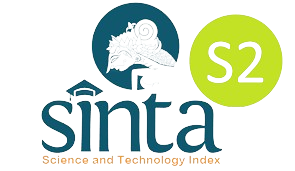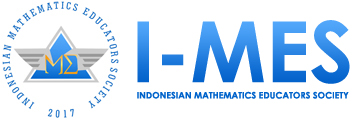The impact of mathematical disposition and self-efficacy beliefs on secondary school students' mathematical literacy
DOI:
https://doi.org/10.29408/jel.v11i1.26873Keywords:
mathematical disposition, mathematical literacy, self-efficacyAbstract
The mathematical literacy skills of Indonesian students, as reflected in the PISA results, continue to be a concern because of their poor performance. Students with high mathematical disposition and high self-efficacy are often more proficient in mathematical literacy. This study aimed to examine how mathematical disposition and self-efficacy affect students’ mathematical literacy skills. This study employed a quantitative approach with a nonexperimental design and adopted a causal associative methodology. Data collection involved administering mathematical disposition and self-efficacy questionnaires, along with a mathematical literacy test, to 56 junior high school students. The analysis was performed using structural equation modeling-partial least squares (SEM-PLS) in the JASP 0.18.3.0 application. The results showed that mathematical disposition significantly enhances both self-efficacy and mathematical literacy skills. Conversely, while self-efficacy positively influenced mathematical literacy skills, the effect was not statistically significant.
References
Akmal, R. A., Sarjana, K., Wulandari, N. P., & Soeprianto, H. (2022). Pengaruh disposisi matematis terhadap kemampuan penalaran matematis pada materi statistika siswa kelas VIII MTsN 3 Mataram tahun ajaran 2022/2023 [The influence of mathematical disposition on mathematical reasoning ability in statistics material of class]. Jurnal Ilmiah Profesi Pendidikan, 7(4b). https://doi.org/10.29303/jipp.v7i4b.904
Aksu, G., & Güzeller, C. O. (2016). Classification of PISA 2012 mathematical literacy scores using decision-tree method: Turkey sampling. Ted Eğitim ve Bilim, 41(185). https://doi.org/10.15390/EB.2016.4766
Alqusyairi, M. S. A., Suherman, S., & Farida, F. (2021). Hubungan literasi lingkungan dan literasi matematis terhadap kemampuan computer self efficacy [The relationship between environmental literacy and mathematical literacy on computer self-efficacy skills]. Jurnal Lebesgue : Jurnal Ilmiah Pendidikan Matematika, Matematika Dan Statistika, 2(2), 153–165. https://doi.org/10.46306/lb.v2i2.62
Bandura, A. (1997). Self-efficacy : the exercise of control. W. H Freeman and Company.
Cheema, J. R. (2018). Effect of math-specific self-efficacy on math literacy: Evidence from a Greek survey. Research in Education, 102(1), 13–36. https://doi.org/10.1177/0034523717741914
Ding, Y. (2016). How do students’ mathematics self-efficacy, mathematics self-concept and mathematics anxiety influence mathematical literacy?—A comparison between shanghai-china and sweden in PISA 2012 [Master Thesis, University of Gothenburg]. http://hdl.handle.net/2077/44943
Gabriel, F., Buckley, S., & Barthakur, A. (2020). The impact of mathematics anxiety on self-regulated learning and mathematical literacy. Australian Journal of Education, 64(3), 227–242. https://doi.org/10.1177/0004944120947881
Gabriel, F., Signolet, J., & Westwell, M. (2018). A machine learning approach to investigating the effects of mathematics dispositions on mathematical literacy. International Journal of Research & Method in Education, 41(3), 306–327. https://doi.org/10.1080/1743727X.2017.1301916
Ghozali, I. (2015). Partial least squares : Konsep, teknik dan aplikasi menggunakan program SmartPLS 3.0, -2/E [Partial least squares: Concepts, techniques and applications using SmartPLS 3.0, -2/E]. Badan Penerbit Undip.
Hair, J. F., Sarstedt, M., Ringle, C. M., & Mena, J. A. (2012). An assessment of the use of partial least squares structural equation modeling in marketing research. Journal of the Academy of Marketing Science, 40(3), 414–433. https://doi.org/10.1007/s11747-011-0261-6
Hapsari, T. (2019). Literasi matematis siswa [Students’ mathematical literacy]. Euclid, 6(1), 84. https://doi.org/10.33603/e.v6i1.1885
Harefa, A. D., Lase, S., & Zega, Y. (2023). Hubungan kecemasan matematika dan kemampuan literasi matematika terhadap hasil belajar peserta didik [The relationship between mathematical anxiety and mathematical literacy skills on student learning outcomes]. Educativo: Jurnal Pendidikan, 2(1), 144–151. https://doi.org/10.56248/educativo.v2i1.96
Henderson, R., Sawtelle, V., & Nissen, J. M. (2020). Gender & self-efficacy: A call to physics educators. The Physics Teacher. https://pubs.aip.org/aapt/pte/article/58/5/345/278511
Hendroanto, A., Istiandaru, A., Syakrina, N., Setyawan, F., Prahmana, R. C. I., & Hidayat, A. S. E. (2018). How students solves PISA tasks: An overview of students’ mathematical literacy. International Journal on Emerging Mathematics Education, 2(2), 129-138. https://doi.org/10.12928/ijeme.v2i2.10713
Hoyles, C. (1982). The pupil’s view of mathematics learning. Educational Studies in Mathematics, 13(4), 349–372. https://doi.org/10.1007/BF00366617
İnal, H., & Turabik, T. (2017). Matematik başarısını etkileyen bazı faktörlerin yordama gücünün yapay sinir ağları ile belirlenmesi [Determining the predictive power of some factors affecting mathematics achievement using artificial neural networks]. Uşak Üniversitesi Eğitim Araştırmaları Dergisi, 3(1), 23–50. https://doi.org/10.29065/usakead.287754
Izzati, N., & Widyastuti, W. (2021). The influence of self-efficacy on students’ mathematical disposition. Eduma : Mathematics Education Learning and Teaching, 10(1), 98-106. https://doi.org/10.24235/eduma.v10i1.8519
kemendikbudristek. (2022). Peraturan menteri pendidikan, kebudayaan, riset, dan teknologi republik Indonesia nomor 5 tahun 2022 tentang kurikulum merdeka [Regulation of the minister of education, culture, research, and technology of the republic of Indonesia number 5 of 2022 concer. https://peraturan.bpk.go.id/Details/224172/permendikbudriset-no-5-tahun-2022
Kilpatrick, J., Swafford, J., & Findell, B. (2001). Adding it Up: Helping children learn mathematics. National Academies Press.
Kunwar, R. (2021). A study on low performing students perception towards mathematics: a case of secondary level community school students of Nepal. Researcher: A Research Journal of Culture and Society, 5(1), 125–137. https://doi.org/10.3126/researcher.v5i1.41384
Kurniati, I. W., Pujiastuti, E., & Kurniasih, A. W. (2017). Model pembelajaran discovery learning berbantuan smart sticker untuk meningkatkan disposisi matematik dan kemampuan berpikir kritis [Discovery learning model assisted by smart stickers to improve mathematical disposition and critical thinking skills]. Kreano, Jurnal Matematika Kreatif-Inovatif, 8(2), 109–118. https://doi.org/10.15294/kreano.v8i2.5060
Marks, G., McMillan, J., & Hillman, K. (2001). Tertiary entrance performance: The role of student background and school factors. https://research.acer.edu.au/lsay_research/24/
Martalyna, W., Asikin, M., & Negeri, S. (2018). Students’ mathematical literacy based on self-efficacy by discovery learning with higher order thinking skills-oriented. Ujmer, 7(1), 54–60.
Mayratih, G. E., Leton, S. I., & Uskono, I. V. (2019). Pengaruh disposisi matematis terhadap kemampuan pemecahan masalah matematis siswa [The influence of mathematical disposition on students’ mathematical problem solving abilities]. Asimtot: Jurnal Kependidikan Matematika, 1(1), 41–49. https://doi.org/10.30822/asimtot.v1i1.97
NCTM. (1988). Curriculum and evaluation standards for school mathematics: Responses from the research community. Journal for Research in Mathematics Education, 19(4), 338. https://doi.org/10.2307/749544
NCTM. (2000). Principles and standards for school mathematics. In Notices of the American Mathematical Society.
Nicolaidou, M., & Philippou, G. (2003). Attitudes towards mathematics, self-efficacy and achievement in problem-solving. European Research in Mathematics Education Iii, 1–11.
Nisa, F. K., & Arliani, E. (2023). Junior high school students’ mathematical literacy in terms of mathematical self-efficacy. Jurnal Elemen, 9(1), 283–297. https://doi.org/10.29408/jel.v9i1.7140
Novita, N., Mellyzar, M., & Herizal, H. (2021). Asesmen nasional (AN): Pengetahuan dan persepsi calon guru [National assessment (AN): Knowledge and perceptions of prospective teachers]. JISIP (Jurnal Ilmu Sosial Dan Pendidikan), 5(1). https://doi.org/10.58258/jisip.v5i1.1568
Nugrahanto, S., & Zuchdi, D. (2019). Indonesia PISA result and impact on the reading learning program in Indonesia. Proceedings of the International Conference on Interdisciplinary Language, Literature and Education (ICILLE 2018). https://doi.org/10.2991/icille-18.2019.77
Nurhayati, H., Hasanah, A., Fitriyah, Y., & Febrianti, T. S. (2024). The Process of Mathematical Literacy in Middle School Students: Analyzing the Role of Mathematical Dispositions. Jurnal Pendidikan MIPA, 25(2), 893–913. https://jurnal.fkip.unila.ac.id/index.php/jpmipa/issue/view/1505
Nurlaili, N., Fauzan, A., Yerizon, Y., Musdi, E., & Syarifuddin, H. (2022). Analisis literasi matematis mahasiswa pada mata kuliah kalkulus integral [Analysis of students’ mathematical literacy in integral calculus courses]. Jurnal Cendekia : Jurnal Pendidikan Matematika, 6(3), 3228–3240. https://doi.org/10.31004/cendekia.v6i3.1734
OECD. (2014). PISA 2012 Results: What Students Know and Can Do. In OECD (Vol. 1). OECD Publishing. https://doi.org/10.1787/9789264201118-en
OECD. (2016). PISA 2015 results (volume I). OECD Publishing. https://doi.org/10.1787/9789264266490-en
OECD. (2019). PISA 2018 Results (Volume I). OECD Publishing. https://doi.org/10.1787/5f07c754-en
OECD. (2023a). PISA 2022 released main survey new mathematics items. OECD Programme for International Student Assessment 2022, June, 53. OECD Publishing.
OECD. (2023b). PISA 2022 results (volume I). OECD Publishing. https://doi.org/10.1787/53f23881-en
Ojose, B. (2011). Mathematics literacy : are we able to put the mathematics we learn into everyday use? Journal of Mathematics Education, 4(1), 89–100.
Ozgen, K. (2013). Self-efficacy beliefs in mathematical literacy and connections between mathematics and real world: The case of high school students. Journal of International Education Research (JIER), 9(4), 305–316. https://doi.org/10.19030/jier.v9i4.8082
Parsons, S., Croft, T., & Harrison, M. (2009). Does students’ confidence in their ability in mathematics matter? Teaching Mathematics and Its Applications, 28(2), 53–68. https://doi.org/10.1093/teamat/hrp010
Rahmanuri, A., Winarni, R., & Surya, A. (2023). Faktor-faktor yang memengaruhi literasi matematika: Systematic literature review [Factors influencing mathematical literacy: systematic literature review]. Didaktika Dwija Indria, 11(6), 1. https://doi.org/10.20961/ddi.v11i6.78579
Rahmawati, W. A., Usodo, B., & Fitriana, L. (2021). Mathematical literacy of students who have high mathematical disposition in solving PISA-like mathematics problems. https://doi.org/10.2991/assehr.k.211122.039
Richardson, M., Abraham, C., & Bond, R. (2012). Psychological correlates of university students’ academic performance: A systematic review and meta-analysis. Psychological Bulletin, 138(2), 353–387. https://doi.org/10.1037/a0026838
Sandjojo, N. (2011). Metode analisis jalur (path analysis) dan aplikasinya [Path analysis method and its applications]. Pustaka Sinar Harapan.
Schulz, W. (2005). Mathematics self-efficacy and student expectations. results from PISA 2003. Educational Research, 11–15.
Sezgin, G. (2017). Factors affecting mathematics literacy of students based on PISA 2012: A cross-cultural examination [Master Thesis]. Ġhsan Doğramaci Bilkent University.
Shaw, C. T., & Shaw, V. F. (1997). Attitudes of first‐year engineering students to mathematics—A case study. International Journal of Mathematical Education in Science and Technology, 28(2), 289–301. https://doi.org/10.1080/0020739970280210
Sutrisno, U., & Adirakasiwi, A. G. (2019). Analisis kemampuan literasi matematis pada soal berorientasi pisa konten uncertainty and data berdasarkan jenis kelamin [Analysis of mathematical literacy skills on PISA-oriented questions with uncertainty and data content based on gender]. Sesiomadika, 1224–1235.
Tariq, V. N., Qualter, P., Roberts, S., Appleby, Y., & Barnes, L. (2013). Mathematical literacy in undergraduates: role of gender, emotional intelligence and emotional self-efficacy. International Journal of Mathematical Education in Science and Technology, 44(8), 1143–1159. https://doi.org/10.1080/0020739X.2013.770087
Üredi, I., & Üredi, L. (2005). İlköğretim 8. sınıf öğrencilerinin öz-düzenleme stratejileri ve motivasyonel inançlarının matematik başarısını yordama gücü [The predictive power of self-regulation strategies and motivational beliefs on mathematics achievement of 8th grade primary school. Mersin Üniversitesi Eğitim Fakültesi Dergisi, 1(2), 250–260.
Yalçın, M., Aslan, S., & Usta, E. (2012). Analysis of PISA 2009 exam according to some variables. Mevlana International Journal of Education, 2(1), 64–71.
Yulianah, L., Supratman, S., & Rahayu, D. V. (2022). Analysis of students’ mathematical literacy on online learning in terms of self-efficacy. Desimal: Jurnal Matematika, 5(1), 51–60. https://doi.org/10.24042/djm.v5i1.10696
Downloads
Published
How to Cite
Issue
Section
License
Copyright (c) 2025 Hanifah Nurhayati, Aan Hasanah, Dadan Dasari

This work is licensed under a Creative Commons Attribution-ShareAlike 4.0 International License.
Authors who publish with the Jurnal Elemen agree to the following terms:
- Authors retain copyright and grant the journal right of first publication with the work simultaneously licensed under Creative Commons Attribution-ShareAlike 4.0 International License (CC BY-SA 4.0).
- Authors are able to enter into separate, additional contractual arrangements for the distribution of the journal's published version of the work (e.g., post it to an institutional repository or publish it in a book), with an acknowledgment of its initial publication in this journal.
- Authors are permitted and encouraged to post their work online (e.g., in institutional repositories or on their website) prior to and during the submission process, as it can lead to productive exchanges, as well as earlier and greater citation of published work.
Jurnal Elemen is licensed under a Creative Commons Attribution-ShareAlike 4.0 International License





